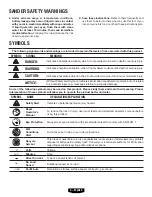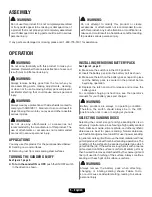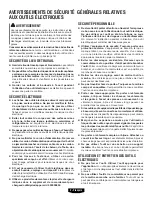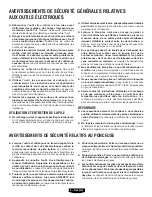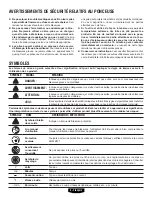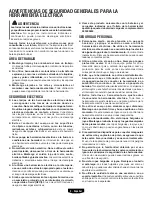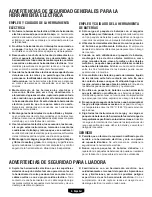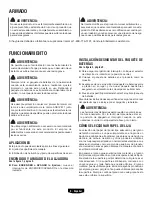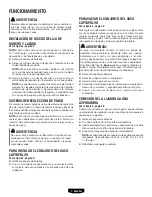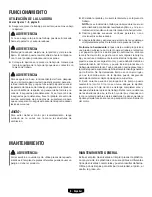
6 – English
ATTACHING HOOK-AND-LOOP SANDING
DISCS
See Figure 3, page 9.
NOTE:
Use only 5 in. hook-and-loop sanding discs which
can be found at local home centers and hardware stores.
Remove the battery pack.
Align the holes in the hook-and-loop sanding disc with
the holes in the backing pad.
NOTE:
Line up the holes in the sanding disc with the
holes in the backing pad in order for the dust collection
feature to function properly.
Press the fuzzy side of the sanding disc against the
backing pad as firmly as possible.
NOTE:
You can reuse hook-and-loop type sanding discs
for the life of the sanding abrasive. We recommend that
you clean the backing pad occasionally by brushing it
lightly with a small brush for best adhesion.
DUST COLLECTION SYSTEM
The dust bag assembly provides a dust collection system
for the sander. Sanding dust is drawn up through the holes
of the sanding disc to collect in the dust bag during sanding
operation.
NOTE:
For more efficient operation, empty dust bag when
no more than half full. This will permit the air to flow through
the bag better.
WARNING:
Do not use the dust bag when sanding metal. Using
the dust bag when sanding metal creates a fire hazard,
which could damage the tool and lead to serious per
-
sonal injury.
ATTACHING THE DUST BAG ASSEMBLY
See Figure 4, page 9.
Remove the battery pack.
Slide the dust bag onto the dust exhaust on the sander
using a slight twisting motion.
EMPTYING THE DUST BAG ASSEMBLY
See Figure 5, page 9.
For more efficient operation, empty the dust bag when it is
no more than half full. This will permit the air to flow through
the bag better. Always empty and clean the dust bag thor
-
oughly upon completion of a sanding operation and before
placing the sander in storage.
OPERATION
WARNING:
Collected sanding dust from sanding surface coatings
such as polyurethanes, linseed oil, etc., can self-ignite
in the sander dust bag or elsewhere and cause fire.
To reduce the risk of fire, always empty the dust bag
frequently while sanding.
Never
store or leave a sander
without totally emptying its dust bag. Also follow the
recommendations of the coatings manufacturers.
Remove the battery pack.
Remove the dust bag assembly from the sander.
Shake out the dust.
For a more thorough cleaning of the dust bag, remove
dust bag from the frame and shake out dust.
Replace the dust bag assembly onto the sander.
ATTACHING THE SANDER TO A VACUUM
See Figure 6, page 9.
When sanding for an extended period of time, you can easily
attach the dust collection system of the sander to a vacuum.
Remove the battery pack.
Remove the dust bag assembly from the sander.
Attach the vacuum hose to the dust exhaust on the
sander.
NOTE:
The vacuum hose fits inside the dust exhaust. The
dust exhaust is designed to fit most 1-1/4 in. or 1-7/8 in.
vacuum connections.
Reinstall the battery pack.
OPERATING THE SANDER
See Figures 7 - 8, page 9.
Secure the workpiece to prevent it from moving under
the sander.
WARNING:
Unsecured workpieces could be thrown towards the
operator, causing injury.
WARNING:
Keep your head away from the sander and the sanding
area. Your hair could be drawn into the sander causing
serious injury.
Place the sander on the workpiece so that all of the
sanding sheet surface is in contact with the workpiece.
Содержание HPSD01
Страница 22: ...NOTES NOTAS ...
Страница 23: ...NOTES NOTAS ...




